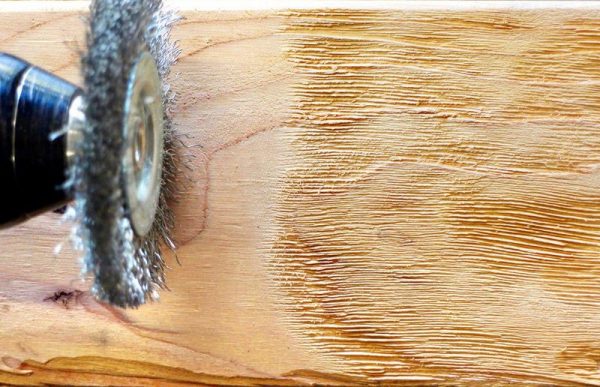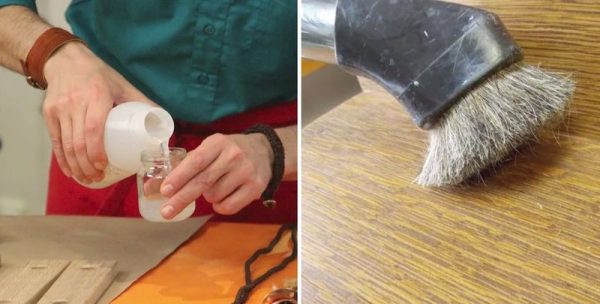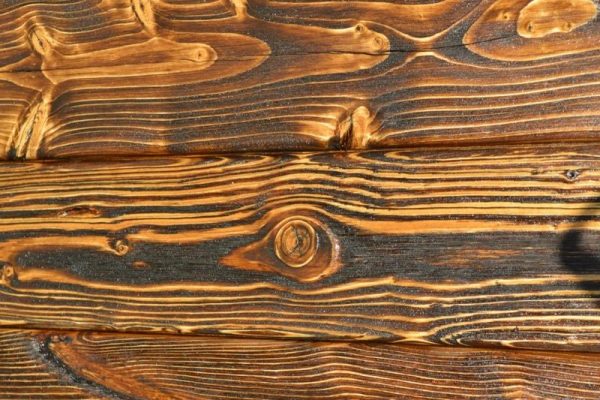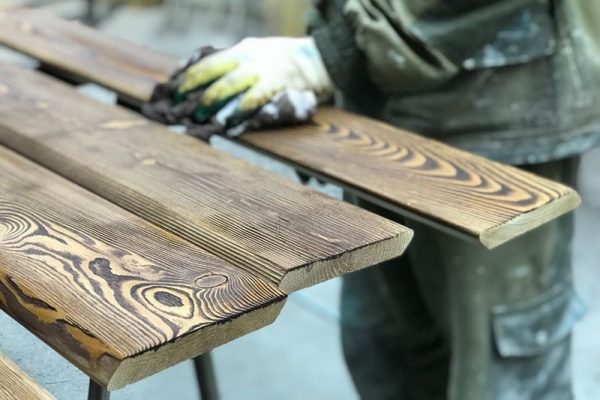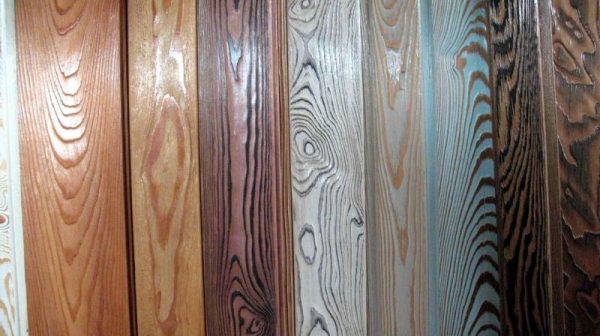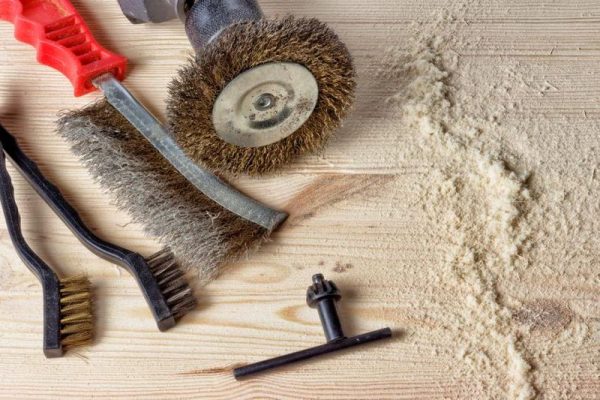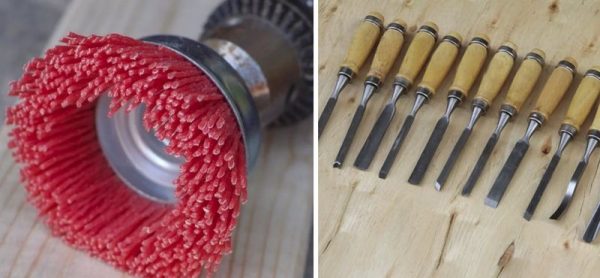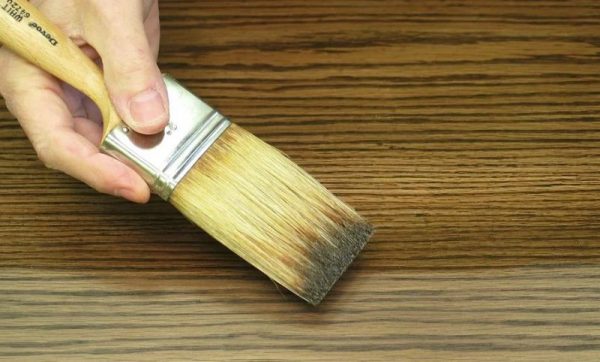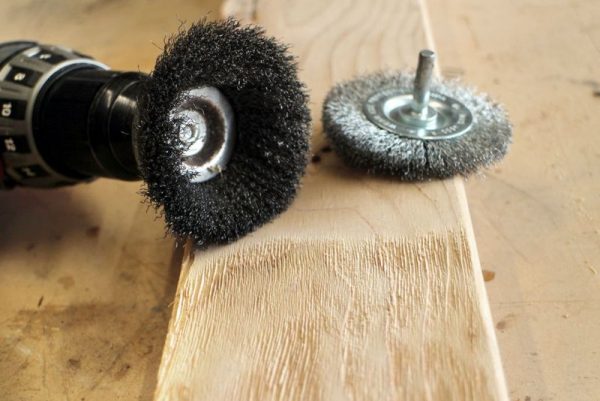Brushing wood is one of the ways to give the material a more decorative look. Brushed wood is widely used by designers, it is used for construction, repair, creating interior items. The technology can be done with your own hands, and without unnecessary time and financial costs.
- What is brushing
- Types of brushing
- Scope of application
- Advantages and disadvantages of technology
- Brushing Instructions
- Suitable tree
- Tools for work
- Coloring or tinting wood
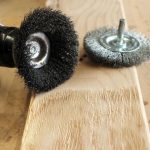
What is brushing
This is a technology of artificial aging of wood. Brushing is a decorative wood treatment with a stiff brush that removes soft fibers and exposes the natural pattern of hard fibers. After such an impact, the material will have a relief surface with a pronounced structure of tree rings.
The essence of brushing is to simulate the process of natural aging of wood. In the spring, when the tree grows rapidly, a lot of soft, loose fibers form in its trunk. After a saw cut, they are subject to rapid abrasion, weathering. Solid rings growing in summer and autumn are more durable, resistant to damaging factors. Soft fibers are easily removed with a brush, as a result, the surface of the wood acquires the relief that is inherent in the old material.
When brushing, the depth of treatment and the degree of removal of soft tissue may vary. The brush is able to penetrate by 0.5-3 mm and even more. Usually the deepest treatment is carried out to give the wood a strong aging effect. Optimal is 0.5-1 mm brushing, which provides the product with a light vintage touch.
to contents ↑
Types of brushing
There are two ways of doing work that have different results:
- Mechanical. It is a classic version of the technology when the wood is treated with a stiff brush, and then painted and polished. The finished surface is embossed.
- Chemical. It implies the processing of wood with special compounds (acids or alkalis) that corrode soft fibers. The relief of the finished board will be less pronounced.
Some masters use a combined brushing method. First, the wood is rough chemically treated, removing a significant part of the soft fibers. Then they finish mechanically, completing the brushing process.
By depth (degree) of processing, brushed wood can be as follows:
- Structured. Such processing is superficial, it is designed to emphasize the annual rings and the natural appearance of the tree.
- Strongly structured. Brushing creates deep furrows along natural tree lines.
- Retro. It has an average processing depth, combined with coloring with special compounds, gives the "appearance" of a long-used material.
- Retro 3D. Allows you to get a very aged material with sharply stressed knots, uneven chamfers.
Scope of application
Brushing technology is widely used in decorating an engineering, massive, parquet board. Also, aging is relevant in relation to wall and ceiling panels, lining, beams, stairs made of wood.Brushed wood is used in the manufacture of furniture - cabinets, tables and chairs, chests of drawers, etc.
Advantages and disadvantages of technology
The natural aging process inevitably reduces the strength of wood. Performing artificial brushing allows you to increase the strength of lumber, prevents the destruction, decay, the appearance of fungus. By properties, the brushing performed is not inferior to the processing of wood with antiseptics, but only subject to strict adherence to technology.
Other advantages of the technique:
- increase the service life of the material;
- the exception of the population of the tree by insects;
- fashionable, exclusive look;
- the ability to create many beautiful things, coatings;
- imitation of expensive varieties of wood;
- emphasizing the naturalness of the material;
- the possibility of using in different interior styles.
to contents ↑There are few drawbacks to brushing. If you do not apply a protective compound, the pores of the wood will be open, and in places with high traffic or in dusty rooms on the tree, dirt will regularly accumulate.
Brushing Instructions
When doing homework, you must strictly follow the sequence of actions, which guarantees an excellent result. If you violate the recommendations, the lumber will be damaged. At the preparatory stage, the level of humidity of the wood is checked. Too dry material is moistened by spraying it with a spray gun. Fresh, damp wood is slightly dried.
to contents ↑
Suitable tree
Beech, maple, pear, alder are not suitable for aging, since they differ in an unclearly pronounced wood structure. The result of brushing on such rocks will not be beautiful, since small fibers will not give a layering effect. Ideal for working rocks with a multilayer structure and a unique natural pattern:
- spruce;
- cedar;
- larch;
- oak;
- Pine.
Brushing technology is also ineffective with respect to tropical plant wood, which does not have a division into annual rings: this is due to the climate. As for the division into hard and soft rocks, brushing can be carried out regardless of such differentiation.
to contents ↑It is acceptable to age plywood, veneered boards, veneer, which allows to improve the relief and create a more expressive surface.
Tools for work
For brushing, special tools are required. At home, they often use hand-held devices that are inexpensive and are sold in any hardware store. For mechanical brushing, a cladding is useful - a rough metal brush with a pile of brass and steel. It is designed to remove soft fibers from the surface layer of wood, while hard tissues remain intact.
When choosing a brush, it is important to pay attention to such points:
- End part. The best tools have a wide end, in shape resembling a roller. They allow you to evenly process wood.
- The thickness of the wire. Brush pile should be 7-10 times thinner than soft fibers of the material, so this parameter must be compared with the type of wood.
- The shape of the bristles. Straight bristles handle better than curly ones. If they are bent, their tips can be cut off on their own.
- Brush stiffness. The shorter the wire, the tougher the brush will be. At the rough stage, it is worth using tools with the most rigid bristles.
Kratsovka removes a significant portion of soft fibers from wood. After that, it is necessary to use devices to eliminate roughness, for which use nylon brushes with abrasive powder pressed into the bristles.The cost of these products is quite high, so many replace them with sandpaper with fine grain. Such a replacement is undesirable, but may occur. For final polishing of wood brushes with sisal or woolen pile are excellent.
From hand tools you may also need:
- Chisel. The tool allows you to apply deep furrows, if required by design. With the help of a chisel, artificial cracks, tears, various patterns are performed.
- Sandpaper with large grain. It is used if necessary to further emphasize the natural pattern of wood. During operation, the sandpaper is pressed along the fibers with pressure.
If mass production of aged wood is planned, or the scope of work is large enough, it is worth replacing hand tools with electric ones. A special brushing machine with speed control is best suited. Also used drills, grinders with special brush heads.
to contents ↑Coloring or tinting wood
After processing the wood with brushes, the finishing stage is carried out - coating the surface with paint, tinting compound, stain to enhance decorative effect. Toning helps to enhance the contrast of the picture, the texture of wood. The process is carried out with a brush or soft sponge.
It is easiest to stain brushed wood with wood stain, which quickly penetrates into the remaining soft fibers and rather slowly into hard ones. The composition is abundantly applied to the surface and the excess is quickly removed to leave light areas with hard tissues. Particularly original looks wood with a stain of gold or silver, beautifully glare in the sun. You can also apply the following techniques:
- painting indentations with a dark tone, and crests with a light tone;
- coating the upper tier with dark varnish, troughs - light;
- patination - painting cracks with the darkest paint.
In the process of tinting, they monitor the “behavior” of wood villi. If they rise strongly to the surface, additional sanding with fine grain sandpaper will be required. Fully dried wood is varnished in order to preserve its presentable appearance for a long time and improve its operational properties. Brushing allows you to give an unusual and luxurious look to any wood products. Carrying out brushing at home is available to everyone and helps to seriously reduce the cost of construction, decoration and design work.

